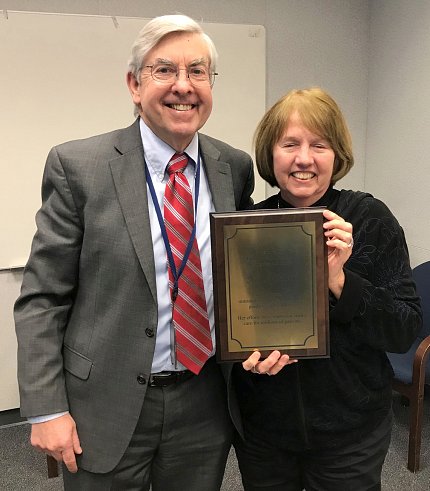NINDS’s Hart Retires After 30 Years of Federal Service

Photo: Andrea Varea
In her career spanning 53 years, Nancy Hart has had many roles—some formal such as naval officer, nurse, professor and writer—and others perhaps not as formal, like CFC keyworker extraordinaire, stroke education champion supreme and overall NINDS outreach program cheerleader. On May 31, she added another title to the list—jubilant retiree. After 30 years of service in the federal government, 23 with NINDS, Hart has officially retired.
“After working fulltime since 1966, I thought now is the time to start a new chapter in my life and do some things I haven’t been able to do,” said Hart.
A native of Bexley, Ohio (a suburb of Columbus), Hart graduated from Bexley High School in 1962 and earned her bachelor of science degree in nursing in 1966 from the University of Michigan School of Nursing. She began her career as a commissioned officer in the Navy Nurse Corps stationed at Bethesda Naval Hospital/National Naval Medical Center (NNMC), where she cared for wounded Marines returning from Vietnam.
“My father was a general practitioner and my mother and her three sisters were trained as nurses,” said Hart. “I was fascinated to hear the stories my mother and aunts told about their nursing experiences and thought it would be a wonderful way to help and serve others. And I loved biology and chemistry in high school.”
After serving a 3-year tour of duty and attaining the rank of lieutenant, she applied for a job at NIH and began working as a research nurse—first in cancer, primarily with leukemia patients, and later with patients being treated for manic depression.
In 1971, Hart earned her master’s degree in health education and human growth and development from the University of Maryland. She began her teaching career in 1975, serving a year as an instructor at American University, where she created and taught a workshop on adolescent suicide. She left AU in 1976 to join the Catholic University staff as an assistant professor of pediatric nursing and human growth and development.
After leaving there in 1978, she became a nursing instructor at Suburban Hospital, where she developed programs designed to on-board new nurses and technicians and created seminars for diabetic patients and their families.
Hart joined Holy Cross Hospital in 1981 as a teaching specialist, creating the first diabetic multidisciplinary health education program for the then-450-bed nonprofit acute care facility. From Holy Cross, Hart moved to work at Options and Choices where she was an advanced nurse clinician and educator, developing health education programs for clients across the country—covering a wide array of health issues from mental health conditions to gastrointestinal disorders.
Before coming to NINDS, Hart returned to NNMC as assistant director of the health promotions department. There, her efforts focused on creating and evaluating health promotion education programs for active duty, retired and civil service personnel. She joined NINDS on Nov. 24, 1996, as a scientific and medical coalition coordinator.
“I have always been passionate about prevention, so I wanted to work in an area where I could play some part in preventing stroke, and this job was a fantastic opportunity to do just that...and on a national level,” Hart said.
At NINDS, she helped launch “Know Stroke. Know the Signs. Act in Time.”—a nationwide educational campaign to increase awareness of new treatments and protocols for stroke. She also responded to stroke inquiries from the public, health professionals and Congress and for 11 years served as a key member of the NIH-wide Take Your Child to Work Day committee—taking the lead in soliciting NINDS scientists and staff to create educational and interactive activities for children.
Hart helped create the Unraveling the Mysteries of the Brain series—an NINDS science educational seminar series for nonscientists. She also served as the first coordinator for the newly formed Parkinson’s disease coordinating committee and was a member of the NINDS social media team. She organized NINDS’s efforts in the USA Science & Engineering Festival and Brain Awareness Week—an international campaign to increase public awareness of brain research.
Among Hart’s most satisfying accomplishments was her work as coordinator of the Brain Attack Coalition. BAC is a group of professional, voluntary and government organizations dedicated to setting direction, advancing knowledge and communicating the best practices to prevent and treat stroke. In April 2017, Hart, a founding member, and BAC marked their 20th anniversary.
“Working with the BAC has given me the opportunity to work with a very diverse group of innovative, creative, dynamic people devoted to improving stroke care. And it is rewarding to think, perhaps, that I have made some contribution to improving the quality of life for people suffering from stroke and perhaps preventing a stroke from occurring,” said Hart.
At their March meeting, BAC members presented Hart with a plaque thanking her for “her years of outstanding service, dedication, guidance and support. Her efforts have improved stroke care for millions of patients.”
Throughout her career, Hart received numerous awards and accolades, including the Allene Van Son Diabetes Educators Award; several NINDS group merit awards for teamwork on stroke; and a special act group award for her role in the 2018 Stroke Twitter chat.
In 2011, Hart and colleagues won a gold Plain Language Award, a Blue Pencil Award and a NINDS Group Merit Award for concept development of an interactive exhibit—the Lobe-oratorium.
In retirement, Hart plans to decompress, relax and spend time with her daughter, son-in-law and four granddaughters. In the fall she intends to take classes: “I am happiest when I am learning new things.”
In parting, Hart offered words from the late Sen. Edward Kennedy: “‘For all those whose cares have been our concern, the work goes on, the cause endures, the hope still lives and the dream shall never die.’ This quote has inspired me for many years. I kept it in a prominent place in my office so I could see it every day and will do the same in retirement.”
